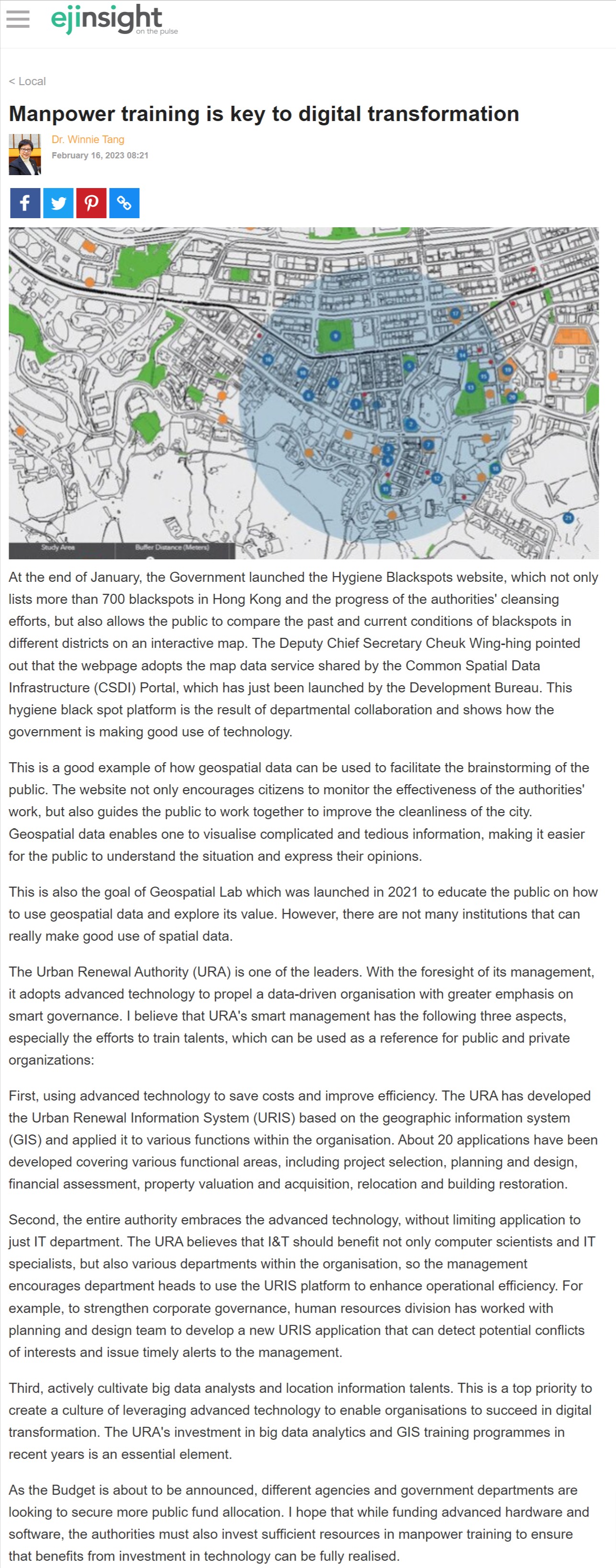網上版請按此

Manpower training is key to digital transformation
At the end of January, the Government launched the Hygiene Blackspots website, which not only lists more than 700 blackspots in Hong Kong and the progress of the authorities' cleansing efforts, but also allows the public to compare the past and current conditions of blackspots in different districts on an interactive map. The Deputy Chief Secretary Cheuk Wing-hing pointed out that the webpage adopts the map data service shared by the Common Spatial Data Infrastructure (CSDI) Portal, which has just been launched by the Development Bureau. This hygiene black spot platform is the result of departmental collaboration and shows how the government is making good use of technology.
This is a good example of how geospatial data can be used to facilitate the brainstorming of the public. The website not only encourages citizens to monitor the effectiveness of the authorities' work, but also guides the public to work together to improve the cleanliness of the city. Geospatial data enables one to visualise complicated and tedious information, making it easier for the public to understand the situation and express their opinions.
This is also the goal of Geospatial Lab which was launched in 2021 to educate the public on how to use geospatial data and explore its value. However, there are not many institutions that can really make good use of spatial data.
The Urban Renewal Authority (URA) is one of the leaders. With the foresight of its management, it adopts advanced technology to propel a data-driven organisation with greater emphasis on smart governance. I believe that URA's smart management has the following three aspects, especially the efforts to train talents, which can be used as a reference for public and private organizations:
First, using advanced technology to save costs and improve efficiency. The URA has developed the Urban Renewal Information System (URIS) based on the geographic information system (GIS) and applied it to various functions within the organisation. About 20 applications have been developed covering various functional areas, including project selection, planning and design, financial assessment, property valuation and acquisition, relocation and building restoration.
Second, the entire authority embraces the advanced technology, without limiting application to just IT department. The URA believes that I&T should benefit not only computer scientists and IT specialists, but also various departments within the organisation, so the management encourages department heads to use the URIS platform to enhance operational efficiency. For example, to strengthen corporate governance, human resources division has worked with planning and design team to develop a new URIS application that can detect potential conflicts of interests and issue timely alerts to the management.
Third, actively cultivate big data analysts and location information talents. This is a top priority to create a culture of leveraging advanced technology to enable organisations to succeed in digital transformation. The URA's investment in big data analytics and GIS training programmes in recent years is an essential element.
As the Budget is about to be announced, different agencies and government departments are looking to secure more public fund allocation. I hope that while funding advanced hardware and software, the authorities must also invest sufficient resources in manpower training to ensure that benefits from investment in technology can be fully realised.
Dr. Winnie Tang
Adjunct Professor, Department of Computer Science, Faculty of Engineering; Department of Geography, Faculty of Social Sciences; and Faculty of Architecture, The University of Hong Kong